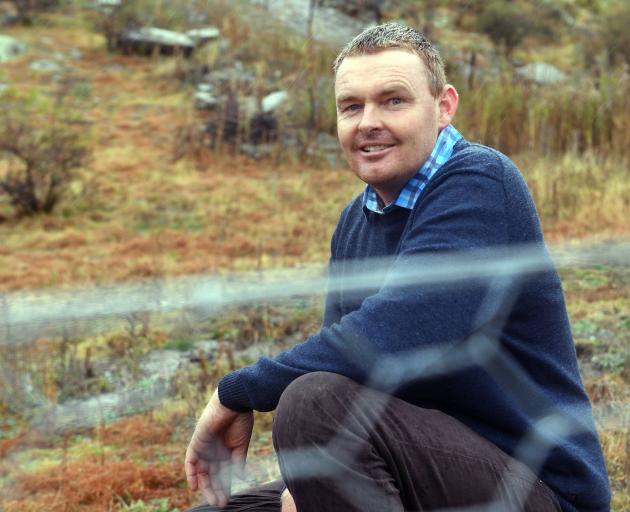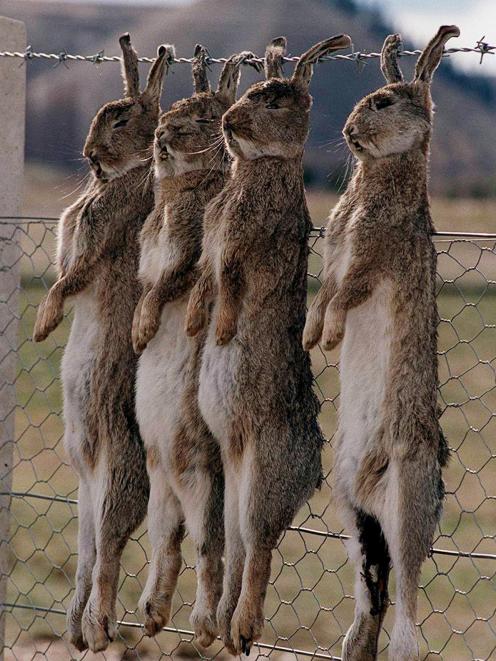
Otago's problems with the long-eared grey/brown menace - the rabbit - began as early as the 1830s, when colonists brought them to New Zealand shores for food and sport.
They quickly realised their mistake as the pests spread and destroyed crops nationwide.
In the 1860s they became established between Invercargill and Riverton, and were devastating crops all over the south by the early 1880s.
Over the next century powers were given to locally-elected rabbit boards to manage the problem, funded by land owners and the Government.
By the mid-1990s, however, some farmers thought they were not seeing results matching their payments, and opted to do the job themselves.
When the rabbit calicivirus disease (RCD) was illegally introduced into New Zealand, in Central Otago in 1997, farmers rejoiced.
RCD was made legal in 1999 and was wildly successful for a time, but it has not been a silver bullet.
Moving forward to today, infestations in many areas are as bad as they ever were.
In the last few years parts of Otago have been plagued - Central Otago, Queenstown Lakes, Waitaki and the Otago Peninsula, particularly.
Otago Regional Council monitoring shows some sites in Cromwell, Roxburgh and Milton have had low rabbit numbers for the last five years.
In comparison, rabbit numbers in Luggate skyrocketed to 27 rabbits persqkm in night counts last year, up from 8.6 in 2006, and near Tarras night count numbers increased to 17.9 from 9.6 in the same time.
Their management is not centralised, and they overrun the countryside.
So what can be done?

Guns remain at the centre of rabbit control.
Earnscleugh station owner Alistair Campbell has waged war on rabbits for nearly 40 years. He has hired a full-time rabbiter on his 20,000ha property near Alexandra for many years.
"We came here in '81 and there were quite a lot. That grew to astronomical levels.''
Regular night shooting reduced the pests to manageable levels.
Now, the rabbiter would shoot between 10 and 20 in a fortnight, or 70 in that time at the height of the season.
"That's very low, that's not even one an hour,'' Mr Campbell says.
He makes the process easier by removing scrub and letting grass grow in unused paddocks.
"We only lightly graze or don't graze in the spring growth period. It makes a cover which the rabbits don't like.''
The rabbits then move to the drier areas and are more easily picked off with guns.
It helps also that the boundaries of the station are almost entirely secured with rabbit-proof fencing. For other landowners who can not afford such measures, Mr Campbell encourages collaboration.
However, he does not want to see the Government involved in management again, which he saw as creating expensive rates and minimal impact.

Culling rabbits on your property means nothing, however, if your neighbour's pests can hop on over.
Samuel Fencing owner Mike Samuel, of Alexandra, said fencing was an essential tool, but only in conjunction with other methods of control.
Business on the rabbit-netting front was fairly consistent in the last 10 years, with "lots of going up'' throughout that time.
It was not impermeable, as younger rabbits often managed to pass though.
You get what you pay for with pest fencing, he says, which can sometimes be a lot.
Quality product is good at keeping the animals at bay, but can cost up to $20 a metre.
"So it's a very expensive option.''
You also have to rely on your neighbours to do the same, and lifestyle block owners do not have the same incentive to cull the animals, he says.
"If they do it, its often just around their house to protect planting.''
Viruses
In theory, viruses are an almost perfect solution.
They have an advantage against poison by spreading naturally and not causing the same collateral damage.
In 1997 the rabbit calicivirus disease was smuggled into New Zealand, which many farmers welcomed, illegally spreading it around their properties.
They hailed it as knocking down the population, but the rabbits bounced back.
The Otago Regional Council released a Korean variant of the virus known as RHDV 1 ``K5'' in March 2018, and boasted a 47% drop in rabbit numbers earlier this year.
This was questioned by some farmers and councillors, as previous results the council provided were gleaned by taking the percentage decrease over monitored areas and averaging them, rather than counting the total decrease in rabbit numbers.
The decline was also highly site-specific, ranging from no difference to an 80% reduction, because of background immunity in the rabbit populations.
The model was taken from the New South Wales government, which released the virus in 2016 and recorded a 36% rabbit decrease.
Testing there showed most of the dead rabbits actually died from another rogue virus, known as RHDV 2.
The regional council confirmed that virus had appeared in Otago late last year.
The head of the Australian state government's programme, Tarnya Cox, said if it was to restart the programme, it would use the RHDV 2 virus instead.
It is more effective partly because K5 does not affect young rabbits in the same way as adults, and so they can develop immunity.
"However if it gets RHDV 2, it dies, so there's a competitive advantage it has over RHDV 1.''
If the New South Wales Government did decide to release that virus, it would be about seven years away because of a long registration process.
As to whether it should be formally released in New Zealand, Dr Cox said it depended on factors specific to our country.
However, it is worth investigating, she says.
The regional council is still monitoring its K5 programme, so it has no plans to release another virus, and has some concerns the two could compete.
Dr Cox, like the regional council, sees the programme as successful.
However, part of that is because education around the issue was as much a goal as killing the animals, she says.
Many farmers do not see it the same way.
Because of how quickly the animals can recover, anything less than a decimation of the population can reverse quickly.
Back at Earnscleugh, Mr Campbell said in the days of large poison drops "an 80% reduction was a failure''.

Poisoning is a culling method which has been successful in bringing sudden blows to rabbit populations.
Maniototo Pest Management manager Ossie Brown says in order for shooting to make any kind of dent in the population, this needs to be done on a large scale first.
Because of operations in the past, poisoning is largely no longer necessary in Maniototo.
"That's good because it's very expensive for the farmer. Afterwards you can't put sheep back for three months.''
As the New Zealand Government and regional council have left rabbit management, poisoning is up to landowners.
Also, unfortunately for some, one of the most effective poisons is 1080, which has spawned a vocal opposition group that has only become emboldened in the past year.
Several properties in Arrow Junction spoke of a neighbour who managed to heavily reduce the number of rabbits on her patch with 1080 poisoning.
Morven Ferry Rd resident Lyn Hamilton said those efforts were very successful on that landowner's property.
However, they received backlash from some people in the community once word got out.
"Some of the people who move here can't even bear the thought of killing a rabbit.''

"Last winter and she got a really hard time from the public. The public probably aren't educated properly on that.''
Up until 2015 land owners could pay the regional council for poison operations, but now its up to individual contractors and requires individual consents.
For smaller landowners the cost is not viable.
Lifestyle Blocks
This brings us to a collection of 4ha spanners in the works.
The Otago countryside is now not just occupied by expanses of paddocks owned by one family, but sprinkled with lifestyle blocks filled with people not necessarily from the rural community.
Mr Johns says on Morven Ferry Rd, which is lined by such properties, the rabbit problem is "really bad''.
He shot, trapped, poisoned and gassed the animals.
"But you can't rely on the neighbours because they're coming from property to property. If fencing is not done properly it causes problems.''
Ms Hamilton says a man was contracted to shoot rabbits for several properties a few years back.
"But he gave up because he couldn't put up with lifestyle blockers giving him a hard time. It is harder, it really is. For example some lifestyle blockers have horses and don't want to move them.
"They get home, put Married at First Sight on, and don't go outside again.''

Otago Regional Council biosecurity and biodiversity team leader Richard Lord says staff have been involved in conversations with territorial authorities advising them to look at rabbit-proof fencing. ``Ultimately though, making rabbit-proof fencing a consent requirement would have to happen within territorial authorities' district plans.''
The council has started with mail drops to some lifestyle block owners, educating them of their rabbit management responsibilities.
Rabbit Boards
The rabbit board model does not seem to be coming back, and for some farmers that is good news.
Rabbit inspectors were developed in the late 1800s when the problem got out of hand.
By the mid-20th century there were about 100 rabbit boards throughout the country, all taking care of an area, co-ordinating and executing culls.
Since the end of the boards, their spirit lives on in the Maniototo Pest Management company.
It works in much the same way, but without Government contribution.
Landowners pay a fee and the company organises poison operations and systematic night shooting.
The system has been held up by many as able to keep rabbits down to manageable levels.
Manager Ossie Brown says during a night out shooting they usually see 20 rabbits, but sometimes the number is as low as five.
Firstly, he says, a population needs to be brought down to a manageable level with co-ordinated poisoning.
The last time it did this on a large scale was in 2008 in conjunction with the regional council.
After that, they can be more easily controlled.
"Now we have intensive night shooting and follow it up with the helicopter in the winter. Usually it's just two of us and we can cover the whole Maniototo.''
Mr Brown worked on rabbit boards since starting on the Kyeburn board in 1971, which later that decade amalgamated with Wedderburn and Patearoa to create the Maniototo Pest Destruction Board.
He says the system had successes and failures.
"When you're dealing with rabbits it's a battle - sometimes they win, sometimes we win.''
Perhaps the most essential element of the system in Maniototo is the co-ordination it creates between land owners.
"To me it's a no-brainer. It makes the farmers co-operate together, it does work and it has been working.''
The council
Regional councillor Graeme Bell advocates for the pest management company model to be introduced in other areas.
He says he made some headway with the last council director in charge of rabbits, Scott MacLean, and needed to get the ball rolling again.
"We were promoting that model for other areas like the Upper Clutha, Alexandra, Manuherikia and Ida Valley basin. I think it's the only way to go.
"It creates collaboration within communities essential to handing an animal with no respect for land titles.
"It also gives residents a sense of agency over their area.
"You don't want any bureaucrat in bloody Dunedin telling you what to do.''
Council staffer Mr Lord said the Maniototo Pest Management model represents a collaborative, community-led approach, which it encourages and supports.
The council's proposed pest plan outlines its approach to feral rabbits over the next ten years, which continues to task landowners with controlling rabbit densities on their properties.
"It requires co-operation and collaboration, and for everyone to do their part.''
The council's role is to educate and support collaboration within community groups, which may involve inspections to ensure neighbours are doing their part.
"We recognise that a lot of landowners [are] already doing great work in this area, which is great for them and for their neighbours.''
In some areas council staff are actively involved in planning for the upcoming poison season, Mr Lord says.
The Future
It is clear every tool available needs to be thrown at an animal which just does not want to go away.
It is also obvious that co-ordination needs to be at the centre.
The council's attempts to educate lifestyle block owners is a start, but councillors and residents need to keep pushing the issue and create or support some kind of structure to deal with the problem.
Once that happens, the work needs to be persistent and continuous.
Even Mr Campbell, for whom much of the year is occupied thinking about rabbits, doubts he will ever be rid of the pests.
"It only takes a change in rabbiter to one less experienced and we could lose control again.''












